
Welcome to Hyperion Records, a British classical label devoted to presenting high-quality recordings of music of all styles and from all periods from the twelfth century to the twenty-first.
Hyperion offers both CDs, and downloads in a number of formats. The site is also available in several languages.
Please use the dropdown buttons to set your preferred options, or use the checkbox to accept the defaults.

| Tedd Joselson (piano), Philharmonia Orchestra, Arthur Fagen (conductor)» More |
| Benno Moiseiwitsch (piano), London Philharmonic Orchestra, Walter Goehr (conductor)» More |
| Simon Barere (piano), Brico Symphony Orchestra, Antonia Brico (conductor)» More |
| Lev Oborin (piano), Radio Orchestra, Alexander Gauk (conductor)» More |
Creatively there were more setbacks than triumphs. Rachmaninov’s dissatisfaction with what he had achieved in his First Concerto was as nothing compared to the trauma that ensued from the 1897 premiere of his First Symphony, distorted as it was under the baton of a reportedly less than entirely sober Glazunov. This was compounded by the more or less routine self-doubts of the young professional musician and by the ongoing tendency to existential listlessness, worthy of a character from Rachmaninov’s much-admired Chekhov. Two visits to the elderly Lev Tolstoy, designed to inspire the young composer, had more or less the reverse effect. At the first the revered author offered merely banal imprecations to daily toil (Tolstoy was by this stage well into his own self-despising phase; he had gone native and was tilling the soil on his estate at Yasnaya Polyana). At the second visit, in the company of Chaliapin and Goldenweiser, Rachmaninov had to endure Tolstoy’s withering response to his music, which was to echo down into the days of Soviet Socialist Realism: ‘Who needs it?’. After his London debut at the Queen’s Hall on 7 April 1899, Rachmaninov was invited to play his First Concerto the following year. Instead, however, he promised to compose ‘a second and better one’. But with his spirits at a low ebb, that was easier said than done.
Famously it was a visit to a friend of a friend (and a near neighbour) of his aunt and cousins that changed everything. Dr Nikolay Dahl was a music-loving doctor who had taken an interest in therapeutic hypnosis – all the rage at the time in France. Psychological malaise being endemic in Russian society, Dahl found plenty of scope for practice, and his results were reputedly impressive. Probably the successful therapy in Rachmaninov’s case had as much to do with conversation with a cultured man who turned to music for consolation as with actual hypnotherapy. At any rate the Second Concerto was released from the composer’s blocked psyche. In gratitude he dedicated the concerto to Dahl (who as an amateur violist would sometimes even play in the piece, garnering applause when his identity was disclosed).
That at least is the official version of events, deriving from Rachmaninov’s own autobiographical notes. However, one family report runs rather differently. According to the composer’s grandson, Alexander, who claims to have been told the story by his grandmother and sworn to secrecy until fifty years after her death, the true reason for Rachmaninov’s visit to Dahl was to court the doctor’s daughter, who was the secret inspiration behind the Second Concerto and who remained a shadowy presence during the composer’s subsequent married life. Alexander told this story to Stephen Hough in person; as yet there is no independent verification, and Rachmaninov scholars regard it with scepticism.
Whatever the true background, Rachmaninov’s creative inertia was overcome, and during the summer of 1900, spent largely with Chaliapin in Milan, he put his ideas for the new Concerto in order. He composed the second and third movements back in Russia and performed them on their own on 2 December in Moscow’s Nobility Hall, with Ziloti conducting. The two cousins would collaborate eleven months later on the first complete performance of the Concerto at the Moscow Philharmonic Society. It was not until May 1902 that London heard the work promised them three years earlier, and a further six months went by before the composer himself played it there (early British performances were given with Ziloti and Basil Sapelnikoff as soloists).
Anyone not knowing that the first movement was composed last might reasonably assume that its famous solo piano opening was the seed-idea for the whole work. This dark-hued progression, with its steady chromatic ascent and bell-like reinforcements in the bass, reappears in various disguises at nodal points in the work: as the closing harmonic progression of the first movement, at the beginning of the second, and, most obviously, just before the first main theme of the finale (after the piano’s opening flourishes). As in the First Concerto, the first movement exposition follows a Griegian pattern, the two main ideas, both of them now gorgeously lyrical, being spaced by brilliant figuration. The central phase, as before largely built on sequences, manages to sound freshly invented while adhering rigorously to existing material. There is no cadenza. Instead the structure unfolds as an unbroken, perfectly proportioned symphonic whole – no question of revision being needed this time. The interweaving of soloist and orchestra is a constant marvel, as is the scoring itself.
As the Concerto’s popularity grew, so its themes were treated to numerous song settings and arrangements, including the slow movement as Prayer for Violin and Piano by Fritz Kreisler ‘in collaboration with the composer’. The basic arpeggio figuration here comes from Rachmaninov’s early Romance for six hands at the piano, composed just after the original version of the First Concerto. The design echoes the slow-fast-slow pattern made famous by Tchaikovsky in his B flat Concerto, though in Rachmaninov’s case the faster music emerges gradually, as if under pressure from the internal force of its lyrical motifs.
Just as the slow movement raised the curtain with a magical modulation to E major from the first movement’s C minor conclusion, so the finale returns to C minor by stealth from the end of the slow movement. Once under way, the finale unfolds another drama of emotional turmoil, longing, regret and tussles with Fate, all the while blending the rhapsody and virtuosity of the Lisztian concerto tradition with the rock-solid craftsmanly values Rachmaninov learned from Taneyev.
Another unverified story behind the Second Concerto has it that Nikita Morozov (a fellow graduate from Arensky’s composition class in 1892, and the same Morozov who criticized the structure of the first movement and nearly plunged Rachmaninov back into creative self-loathing) actually composed the finale’s beautiful second melody and, on hearing of his friend’s admiration for it, allowed him to borrow it. In 1946, three years after Rachmaninov’s death, this would become the hit tune ‘Full Moon and Empty Arms’. And among films that featured extracts from the Second Concerto were Billy Wilder’s The Seven Year Itch (1955) and David Lean’s Brief Encounter (1946), the latter brilliantly matching the music to a scenario of emotional triumph longed-for but probably only achievable in fantasy (a scenario perhaps closer to the origins of the piece than previously imagined, if the story told by the composer’s grandson has any basis in reality).
from notes by David Fanning © 2004
C’est une célèbre visite à l’ami d’un ami (presque un voisin) de sa tante et de ses cousins qui changea le cours des événements. Dr Nikolaï Dahl était un praticien mélomane qui s’intéressait aux utilisations thérapeutiques de l’hypnose – c’était alors à la mode en France. Les malaises psychologiques étant endémiques dans la société russe, Dahl avait à sa disposition de nombreux sujets sur qui s’exercer. Ses résultats étaient impressionnants, d’après ce qu’on en disait à l’époque. Il est probable que la réussite de la thérapie, dans le cas de Rachmaninov, a tenu autant à la conversation avec un homme cultivé qui se tournait vers la musique pour réconfort qu’à l’hypnose à proprement parler. Quoi qu’il en soit, le Concerto pour piano no2 fut libéré de la psyché figée du compositeur. Empreint de reconnaissance, il le dédia à Dahl (qui, en altiste amateur jouait parfois l’œuvre, recevant des applaudissements nourris quand son identité était dévoilée).
Voici la version officielle de l’histoire, dérivée des propres notes autobiographiques de Rachmaninov. Il existe pourtant une version familiale toute différente. Selon le petit-fils du compositeur, Alexandre, qui tenait l’histoire de sa grand-mère mais avait promis de la garder secrète jusque cinquante ans après sa mort, la véritable raison derrière la visite de Rachmaninov à Dahl se trouvait être la fille du docteur qu’il cherchait à courtiser. C’est elle qui serait l’inspiration secrète derrière le Concerto no2. C’est elle qui demeura une ombre présente durant la vie maritale que le compositeur connut ensuite. Alexandre a conté cette version des faits à Stephen Hough. Il n’existe aucun moyen de la corroborer et les spécialistes de Rachmaninov font preuve à son égard d’un scepticisme certain.
Quel que soit le véritable contexte, Rachmaninov avait vaincu son inertie créative. Durant l’été 1900 qu’il passa en grande partie avec Chaliapine à Milan, il consigna par écrit ses idées pour un nouveau Concerto. A son retour en Russie, il écrivit les deuxième et troisième mouvements qu’il exécuta le 2 décembre, dans la Salle de la Noblesse à Moscou, sous la direction de Ziloti. Les deux cousins allaient de nouveau collaborer onze mois plus tard pour la création du Concerto donnée à la Société philharmonique de Moscou. Ce n’est qu’en mai 1902 que Londres put le découvrir, trois ans après la promesse de Rachmaninov et six mois avant que celui-ci ne vienne l’exécuter en personne. (Les premières exécutions britanniques furent données par Ziloti et Basil Sapelnikoff.)
Quiconque ignorerait que le premier mouvement fut écrit en dernier pourrait raisonnablement croire que la célèbre entrée du solo de piano fut l’idée dont toute l’œuvre a germé. Cette progression aux teintes sombres avec ses mouvements ascendants chromatiques réguliers et ses renforcements aux allures de cloches dans le grave réapparaît sous des atours divers aux endroits cruciaux de l’œuvre: lors de la progression harmonique conclusive du premier mouvement, au début du deuxième et évidemment, juste avant l’énoncé du thème principal du finale (après les figurations initiales du piano). Comme dans le Concerto no1, l’exposition du premier mouvement suit un schéma typique de Grieg, les deux idées principales, toutes deux superbement lyriques, étant séparées par de brillantes figurations. La section centrale, largement élaborée sur des séquences (comme précédemment), parvient à donner l’impression d’une fraîcheur d’invention tout en adhérant rigoureusement au matériau thématique existant. Aucune cadence n’y est incorporée. La structure se déploie au contraire comme un tout symphonique continu, parfaitement proportionné – aucune révision n’était nécessaire cette fois. La manière dont le soliste et l’orchestre s’entremêlent est une merveille constante, tout comme l’orchestration.
Au fur et à mesure que la popularité du concerto grandissait, ses thèmes étaient repris à travers maints arrangements pour la voix et autres formations. Le mouvement lent notamment devint une Prière pour violon et piano dans l’arrangement de Fritz Kreisler réalisé «en collaboration avec le compositeur». Les figurations arpégées proviennent de la Romance de jeunesse de Rachmaninov qu’il conçut pour piano six mains juste après la version initiale du Concerto no1. On retrouve dans sa structure un écho du schéma lent-vif-lent que Tchaïkovski rendit célèbre avec son Concerto en si bémol majeur, même si dans le cas de Rachmaninov, le passage vif émerge progressivement, comme poussé par les forces intrinsèques des motifs lyriques.
De la même manière que le mouvement lent levait le rideau avec une modulation magique en mi majeur après la conclusion en do mineur du premier mouvement, le finale retrouve ce do mineur discrètement dès la fin du mouvement lent. A peine commencé, le finale dévoile la trame d’un autre drame – tourment émotionnel, langueur, regret, lutte avec le Destin – tout en associant la rhapsodie et la virtuosité d’un concerto de tradition lisztienne au savoir-faire et valeurs solides que Rachmaninov avait appris auprès de Taneïev.
extrait des notes rédigées par David Fanning © 2004
Français: Isabelle Battioni
Ein berühmter Aufenthalt bei einem Freund eines Freundes (und Nachbarn) seiner Tante und Cousins sollte ihm aus der Misere helfen. Dr. Nikolay Dahl war ein musikliebender Arzt, der sich für therapeutische Hypnose interessierte, was zu der Zeit in Frankreich hochmodern war. Da psychische Malaisen in der russischen Gesellschaft geradezu endemisch waren, bot sich Dahl ein großes Untersuchungsfeld und seine Ergebnisse sollen beeindruckend gewesen sein. Wahrscheinlich war in Rachmaninows Fall nicht nur aufgrund der Hypnose-Therapie so erfolgreich, sondern auch, da er sich mit einem kultivierten Mann austauschen konnte, dessen Trost die Musik war. Wie dem auch sei, das Zweite Klavierkonzert konnte entstehen und aus der umgürteten Psyche des Komponisten befreit werden. Als Zeichen des Dankes widmete er Dahl das Konzert, der als Laien-Bratschist manchmal sogar das Stück mitspielte und besonderen Applaus erntete, wenn seine Identität enthüllt wurde.
So jedenfalls die offizielle Version der Ereignisse, entsprechend der autobiographischen Aufzeichnungen Rachmaninows. In der Familie kursiert jedoch auch eine recht unterschiedliche Fassung. Dem Enkel des Komponisten zufolge, der behauptet, dass seine Großmutter ihm die Geschichte unter der Bedingung erzählt habe, dass er sie bis fünfzig Jahre nach ihrem Tod geheim halte, sei der wahre Grund für Rachmaninows Besuch bei Dahl dessen Tochter gewesen, die die heimliche Inspiration zu dem Zweiten Klavierkonzert gewesen sei, und die während der dann folgenden Ehe des Komponisten eine mysteriöse Anwesenheit gepflegt habe. Der Enkel, Alexander, erzählte Stephen Hough diese Geschichte selbst; bisher wurde sie von unvoreingenommener Seite noch nicht bestätigt und Rachmaninow-Forscher betrachten sie als zweifelhaft.
Was der wahre Grund auch gewesen sein mag, Rachmaninows kreative Trägheit war überwunden und während des Sommers im Jahre 1900, den er zum größten Teil mit Chaliapin in Mailand verbrachte, ordnete er seine Ideen für das neue Konzert. Er komponierte den zweiten und dritten Satz, als er wieder in Russland war und führte sie (ohne den ersten Satz) am 2. Dezember in der Moskauer Adelshalle unter der Leitung von Ziloti auf. Elf Monate später sollten die beiden Cousins das Konzert bei der Moskauer Philharmonischen Gesellschaft zum ersten Mal in Gänze aufführen. Erst im Mai 1902 war das Werk zum ersten Mal in London zu hören, drei Jahre später als ursprünglich versprochen, und es dauerte weitere sechs Monate, bis der Komponist es selbst spielte (die ersten Aufführungen wurden mit Ziloti und Basil Sapelnikoff als Solisten gegeben).
Wer nicht weiß, dass der erste Satz zuletzt entstand, könnte begreiflicherweise annehmen, dass die berühmte Anfangspassage des Soloklaviers der Keim des restlichen Werks sei. Jene dunkle Fortschreitung mit ihrem beständigen chromatischen Aufstieg und glockenähnlichen Verstärkungen im Bass erscheint, unterschiedlich verschleiert, an den Knotenpunkten des Werks wieder. So etwa bei der Schlussfigur des ersten Satzes, am Anfang des zweiten Satzes und, am deutlichsten, kurz vor dem ersten Hauptthema des Finalsatzes (nach den Anfangsgesten des Klaviers). Ebenso wie im Ersten Klavierkonzert beruft sich die Exposition des ersten Satzes auf Grieg; die Hauptthemen, diesmal beide herrlich lyrisch, sind in brillante Figurierungen eingebettet. Der Mittelteil, wie zuvor hauptsächlich aus Sequenzen bestehend, klingt wie neu erfunden, obwohl das bereits bestehende Material strikt beibehalten wird. Es gibt keine Kadenz. Stattdessen entfaltet sich die Struktur als ein ungebrochenes, perfekt proportioniertes symphonisches Ganzes – dieses Werk bedurfte keiner Überarbeitung. Das Zusammenspiel und die Verbundenheit des Solisten und Orchesters ist fantastisch, wie auch die Komposition selbst.
Das Konzert wurde zunehmend beliebter und daraufhin entstanden diverse Lieder und Arrangements, in denen die Themen des Konzerts verarbeitet waren, darunter der langsame Satz als Gebet für Geige und Klavier von Fritz Kreisler „in Zusammenarbeit mit dem Komponisten“. Die hier vorherrschenden Arpeggiofiguren stammen aus Rachmaninows früher Romanze für sechs Hände am Klavier, die er kurz nach dem Ersten Klavierkonzert (in seiner ursprünglichen Fassung) komponierte. In der Anlage stützt Rachmaninow sich auf das Muster langsam-schnell-langsam, das Tschaikowsky mit seinem B-Dur Konzert popularisiert hatte. Bei Rachmaninow tritt der schnelle Teil jedoch erst nach und nach in den Vordergrund, als sei er unter dem Druck der inneren Kraft der lyrischen Motive.
Ebenso wie der langsame Satz den Vorhang mit einer zauberhaften Modulation nach E-Dur von dem Ende des ersten Satzes in c-Moll öffnet, so kehrt das Finale heimlich nach c-Moll von dem Ende des langsamen Satzes aus zurück. Wenn es einmal begonnen hat, entwickelt sich im Finale ein weiteres Drama von Gefühlschaos, Sehnsucht, Bedauern und Gerangel mit dem Schicksal. Derweil werden die rhapsodischen und virtuosen Elemente aus der Lisztschen Solokonzert-Tradition mit den festen handwerklichen Werten, die Rachmaninow von Taneyev erlernt hatte, miteinander verwoben.
aus dem Begleittext von David Fanning © 2004
Deutsch: Viola Scheffel
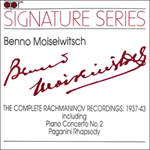 Benno Moiseiwitsch - The complete Rachmaninov recordings, 1937-43 Benno Moiseiwitsch - The complete Rachmaninov recordings, 1937-43This is a recording from Appian Publications & Recordings Ltd (to quote the full title)—the label invariably more familiarly known simply as "APR". Since its foundation in 1986, APR has won an enviable reputation as a quality label devoted ...» More |
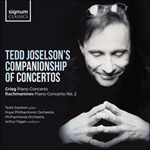 Grieg & Rachmaninov: Piano Concertos Grieg & Rachmaninov: Piano ConcertosStyled 'Tedd Joselson's Companionship of Concertos', the American pianist presents two favourites from his lengthy career: the Grieg, and Rachmaninov's second.» More |
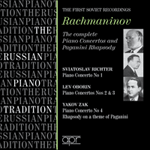 Rachmaninov: Piano Concertos Rachmaninov: Piano Concertos |
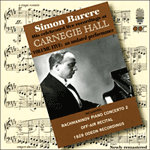 Simon Barere – His celebrated live recordings at Carnegie Hall, Vol. 5 - Rachmaninov's Piano Concerto No 2 & appendices Simon Barere – His celebrated live recordings at Carnegie Hall, Vol. 5 - Rachmaninov's Piano Concerto No 2 & appendices'The fifth and final volume of Simon Barere’s live Carnegie Hall performances includes a fascinating, typically vertiginous performance of Rachmaninov ...» More |
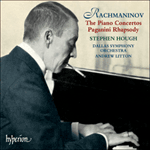 Rachmaninov: The Piano Concertos Rachmaninov: The Piano Concertos |

